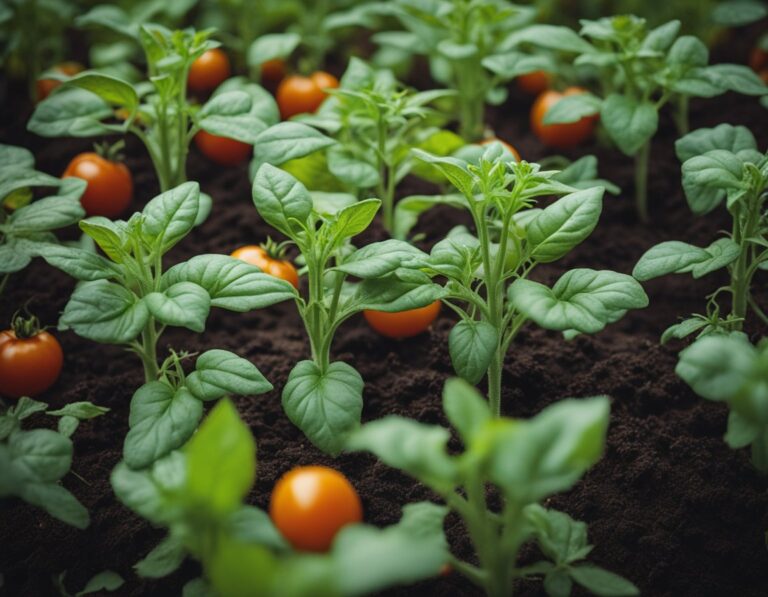White Gnats on Tomato Plants: How to Get Rid of Them
If you’re a tomato gardener, you may have come across white gnats on your tomato plants. These tiny insects can be a nuisance and can even harm your plants if left untreated.
In this article, we will discuss how to identify white gnats on tomato plants, the impact they can have on your crop, and how to prevent and control them.
Identifying white gnats on tomato plants is the first step in controlling them. These insects are usually found on the underside of the leaves and can be identified by their small size and white color.
They are often mistaken for whiteflies, but unlike whiteflies, white gnats are attracted to moist environments and decaying organic matter. If you’re not sure whether you have white gnats or another pest, you can use a magnifying glass to get a closer look.
White gnats on tomato plants can have a significant impact on your crop. They feed on the sap of the leaves and can cause wilting, yellowing, and stunted growth. In severe cases, they can even kill the plant.
It’s essential to take action as soon as you notice them to prevent further damage. In the next section, we will discuss how to prevent and control white gnats on tomato plants.
Key Takeaways
- Identifying white gnats on tomato plants is crucial for controlling them.
- White gnats can harm your plants by feeding on the sap of the leaves.
- Preventing and controlling white gnats involves removing decaying organic matter and using sticky traps or insecticidal soap.
White Gnats on Tomato Plants
If you notice small, white flying insects around your tomato plants, they are likely whiteflies. These tiny insects can quickly multiply and cause damage to your plants. Here are some things to keep in mind if you see white gnats on your tomato plants:
- Identifying Whiteflies: Whiteflies are small, white insects that are about 1/16 inch long. They are usually found on the undersides of leaves and can be identified by their white, waxy appearance. When disturbed, they will fly off the plant in a flurry.
- Damage to Plants: Whiteflies can cause significant damage to tomato plants by feeding on the sap and causing leaves to turn yellow and fall off. They can also transmit viruses that can cause stunted growth and reduced yields.
- Prevention and Control: To prevent whiteflies from infesting your tomato plants, it is important to keep the area around them clean and free of debris. You can also introduce natural predators, such as ladybugs or lacewings, to help control the population. If whiteflies are already present, you can use insecticidal soap or neem oil to control them. Be sure to follow the instructions carefully and apply the product to both the tops and bottoms of leaves.
- Other Pests: White gnats on tomato plants may also be a sign of other pests, such as aphids or thrips. These pests can also cause damage to your plants and should be treated accordingly.
- Conclusion: White gnats on tomato plants can be a sign of a serious pest problem. By identifying the pest and taking steps to prevent and control it, you can help keep your tomato plants healthy and productive.
Identifying White Gnats
If you notice small white insects flying around your tomato plants, you may be dealing with white gnats. These pests are also known as whiteflies and can cause significant damage to your tomato plants if left unchecked.
Here are some key characteristics to help you identify white gnats on your tomato plants:
- White gnats are small, moth-like insects that are about 1/16 to 1/8 inch in length.
- They have a powdery, white appearance and are often found in clusters on the undersides of leaves.
- When disturbed, they will fly up in a cloud, which can be a telltale sign of an infestation.
- White gnats are most active during the warmer months and can reproduce quickly, leading to a severe infestation in a short amount of time.
It is important to identify white gnats early on to prevent them from causing damage to your tomato plants. If you notice any of these signs, it is essential to take action immediately to control the infestation.
In the next section, we will discuss some effective methods for getting rid of white gnats on tomato plants.
Impact of White Gnats on Tomato Plants
White gnats, also known as whiteflies, can have a significant impact on the health and yield of your tomato plants. These tiny insects feed on the sap of the plant, which can cause stunted growth, yellowing of leaves, and reduced fruit production.
In addition to directly damaging the plant, white gnats can also transmit diseases to your tomato plants. For example, the Tomato Yellow Leaf Curl Virus is a common disease that is spread by white gnats. This virus can cause severe damage to your tomato plants, including leaf curling, yellowing, and reduced fruit production.
If left untreated, a white gnat infestation can quickly get out of control and cause significant damage to your tomato plants. Therefore, it is important to take action as soon as you notice the presence of these pests.
There are several ways to control and prevent white gnats on your tomato plants. One effective method is to use sticky traps. These traps are coated with a sticky substance that attracts and traps the white gnats. You can place these traps near your tomato plants to help control the population.
Another effective method is to use insecticidal soap or neem oil. These products are safe for use on tomato plants and can help control the white gnat population. However, it is important to follow the instructions carefully and not overuse these products, as they can also harm beneficial insects.
Finally, it is important to maintain good hygiene practices in your garden. Remove any dead or diseased plant material, as this can attract white gnats and other pests. Additionally, make sure to water your tomato plants properly and avoid over-fertilizing, as this can also attract pests.
By taking these steps, you can help control and prevent white gnats on your tomato plants, ensuring a healthy and productive harvest.
Preventing and Controlling White Gnats
White gnats, also known as fungus gnats, are a common problem for tomato plants. These tiny insects lay their eggs in the soil, and the larvae feed on the roots of the plant.
This can cause stunted growth, yellowing leaves, and even death of the plant. Fortunately, there are several measures you can take to prevent and control white gnats.
Preventive Measures
Prevention is the best way to deal with white gnats. Here are some preventive measures you can take to keep them away from your tomato plants:
- Use a sterile potting mix: Fungus gnats thrive in moist soil, so using a sterile potting mix that is free of fungus spores can help prevent an infestation.
- Water properly: Overwatering creates the perfect environment for white gnats to thrive. Allow the top layer of soil to dry out between waterings.
- Use yellow sticky traps: Fungus gnats are attracted to the color yellow, so placing yellow sticky traps around your tomato plants can help trap and kill them.
- Use beneficial nematodes: Beneficial nematodes are microscopic worms that feed on the larvae of white gnats. Adding them to your soil can help prevent an infestation.
- Use hydrogen peroxide: Watering with a mixture of hydrogen peroxide and water can kill the larval stage of white gnats. Mix one cup of water with one tablespoon of hydrogen peroxide and water your tomato plants with the solution.
Control Measures
If you already have an infestation of white gnats, there are several control measures you can take to get rid of them:
- Use yellow sticky traps: As mentioned above, yellow sticky traps can help trap and kill white gnats.
- Use neem oil: Neem oil is a natural insecticide that can kill white gnats. Mix one tablespoon of neem oil with one quart of water and spray the solution on your tomato plants.
- Use Bacillus thuringiensis (BT): BT is a natural bacteria that can kill the larvae of white gnats. Mix one tablespoon of BT with one quart of water and spray the solution on your tomato plants.
- Use diatomaceous earth: Diatomaceous earth is a natural powder that can kill white gnats. Sprinkle the powder on the soil around your tomato plants.
Additional Tips for Healthy Tomato Plants
In addition to getting rid of white gnats on tomato plants, there are a few things you can do to ensure that your tomato plants remain healthy and produce a bountiful harvest.
Proper Spacing Between Tomato Plants
One of the most important things you can do for your tomato plants is to give them enough space to grow. Tomato plants need plenty of room to spread out and get the sunlight and nutrients they need to thrive.
When planting your tomato plants, make sure to space them out according to the variety you are planting. For determinate tomato varieties, plant them 12-24 inches apart. For indeterminate varieties, plant them 24-36 inches apart.
Provide Adequate Water and Nutrients
Tomato plants need plenty of water and nutrients to grow strong and healthy. Make sure to water your tomato plants regularly, especially during hot, dry weather.
You can also add compost or fertilizer to the soil to provide your plants with the nutrients they need to thrive. Just be careful not to over-fertilize your plants, as this can lead to excessive foliage growth and reduced fruit production.
Prune Your Tomato Plants
Pruning your tomato plants can help them produce more fruit and stay healthy. Remove any suckers that grow in the crotch between the main stem and the
branches, as these can divert energy away from the main stem and reduce fruit production. You can also remove any yellow or diseased leaves to prevent the spread of disease.
Stake or Cage Your Tomato Plants
Staking or caging your tomato plants can help keep them upright and prevent them from falling over as they grow. This can also help improve air circulation around the plants, which can reduce the risk of disease.
When staking your tomato plants, use a sturdy stake that is at least 6 feet tall and secure the plant to the stake using soft ties. When using a cage, make sure to choose a cage that is the appropriate size for your plant and secure it firmly in the ground.
By following these tips, you can help ensure that your tomato plants remain healthy and productive throughout the growing season.
Frequently Asked Questions
How do I get rid of white flies on my tomato plants?
Whiteflies can be a real nuisance when they infest your tomato plants. Here are some ways you can get rid of them:
- Use a vacuum cleaner: This may sound strange, but it’s an effective way to get rid of whiteflies. Simply vacuum them up and dispose of them.
- Use sticky traps: Place yellow sticky traps around your tomato plants to attract and trap whiteflies.
- Use insecticidal soap: This is a natural and safe way to get rid of whiteflies. Spray your tomato plants with insecticidal soap to kill the whiteflies.
What is a natural remedy for whitefly on tomatoes?
There are several natural remedies you can use to get rid of whiteflies on your tomato plants:
- Neem oil: Neem oil is a natural insecticide that can be used to kill whiteflies. Mix it with water and spray it on your tomato plants.
- Garlic spray: Crush some garlic cloves and mix them with water. Spray the mixture on your tomato plants to repel whiteflies.
- Essential oils: Essential oils like peppermint, rosemary, and eucalyptus can be used to repel whiteflies. Mix a few drops of essential oil with water and spray it on your tomato plants.
What are the little white fuzzy bugs on my tomato plants?
The little white fuzzy bugs on your tomato plants are most likely whiteflies. Whiteflies are small, winged insects that feed on the sap of plants. They are a common pest on tomato plants.
How do I keep whiteflies off my plants?
Here are some ways you can keep whiteflies off your tomato plants:
- Keep your plants healthy: Whiteflies are attracted to weak and stressed plants. Make sure your tomato plants are healthy and well-nourished.
- Use row covers: Cover your tomato plants with row covers to prevent whiteflies from infesting them.
- Introduce natural predators: Ladybugs and lacewings are natural predators of whiteflies. Introduce them to your garden to keep whiteflies under control.
What are some chemical controls for whitefly on tomato plants?
If natural remedies don’t work, you can use chemical controls to get rid of whiteflies on your tomato plants. Here are some options:
- Insecticidal soap: Spray your tomato plants with insecticidal soap to kill whiteflies.
- Pyrethrin: Pyrethrin is a natural insecticide that can be used to kill whiteflies.
- Neonicotinoids: Neonicotinoids are a class of insecticides that can be used to control whiteflies.
What are the tiny black flies on tomato plants?
The tiny black flies on your tomato plants are most likely fungus gnats. Fungus gnats are small, dark-colored flies that feed on decaying organic matter. They are not harmful to tomato plants, but they can be a nuisance.
To get rid of them, allow the soil to dry out between waterings and remove any decaying organic matter from the soil.



